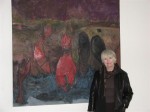‘Wright’ or Wrong? “The Women” by T.C. Boyle
 Frank Lloyd Wright was an architect who sported capes and odd caps, a short Napoleon of the drafting board, given to ego-driven decisions. The roofs of his cutting-edge homes leaked, and in an era of cheap fuels for heating, he skimped on insulation in order to produce sleek modernist dwellings.
Frank Lloyd Wright was an architect who sported capes and odd caps, a short Napoleon of the drafting board, given to ego-driven decisions. The roofs of his cutting-edge homes leaked, and in an era of cheap fuels for heating, he skimped on insulation in order to produce sleek modernist dwellings.
I’ve lived in several homes designed by Wright-wannabes, and yes, the roofs leaked and the houses were freezers in the winter. One of my homes (designed by Wisconsin’s Michael Johnson who went on to fame and fortune in Arizona and elsewhere) actually had ice on the interior walls in the winter of 1980, but god, how it brought the outside in, albeit at times too literally.
When the moon’s path traversed the south facing diamond-shaped window, the world stood still. In Bay View I dwelt in a Usonian post and beam dream/disaster, sometimes sleeping under plastic sheeting to avoid the consequences of rain and snow on a flat roof design. I can’t blame that one on Wright, however.
In conjunction with the Milwaukee Art Museum’s exhibition, Frank Lloyd Wright: Organic Architecture for the 21st Century (Feb. 12-May 15), I read The Women by T. C. Boyle, who bought a 1909 FLW home in Montecito, California. The roof leaked, and the redwood wonder was in need of a foundation. He wrote The Women because he wanted to know more about the architect who designed the house, or so says a February, 2011 article in Smithsonian magazine.
How’s this for an opener:.
“…but it was an automobile that took me to Taliesin in the fall of 1932, through a country alternately fortified with trees and rolled out like carpet to the back wall of its barns, hayricks and farmhouses, through towns with names like Black Earth, Mazomanie and Coon Rock….”
We’re in Wisconsin as seen through the eyes of Tadashi Sato, a fictional Japanese chap who arrives in a Stutz Bearcat, intent on apprenticing with Wright. His first assignment is peeling onions for the Master, because yes, Taliesin types were expected to pitch in at the cozy commune set near Spring Green. Flash back to 1924, where, on a rainy Chicago night, fate decrees that he meet Olga Lazovich Milanoff Hinzenberg, who would become wife #3, the previous two having fled the coop run by the Master who crowed on and on.
The plot thickens as author Boyle stirs the stew, blending fact and fiction in the 451 page-turner. You’d almost think Boyle was getting even with the architect who designed his aforementioned 1909 Montecito pad, you know, the one with the problematical leaks.
By telling the tale through the eyes of Tadashi (who resembles a Japanese Puck or a character from Rashomon), the author avoids the unbearable heaviness of objectivity and goes for juicy subjectivity. Morphine addicts (wife #2), sex among the sunflowers, fires galore (Taliesin burned twice) and much more, including murder, make for a romp through time.
Don’t for a minute surmise that Boyle is out to cast stones at people who live in glass houses, though when he chooses to lob a few, his aim is perfect. After all, who among us prefer their heroes squeaky clean? Frankly, I dig Superman when his tights are a tad wrinkled.
Art
-
It’s Not Just About the Holidays
 Dec 3rd, 2024 by Annie Raab
Dec 3rd, 2024 by Annie Raab
-
After The Election Is Over
 Nov 6th, 2024 by Annie Raab
Nov 6th, 2024 by Annie Raab
-
The Spirit of Milwaukee
 Aug 30th, 2024 by Annie Raab
Aug 30th, 2024 by Annie Raab





















2/24-7 pm @ Boswell Books
right?